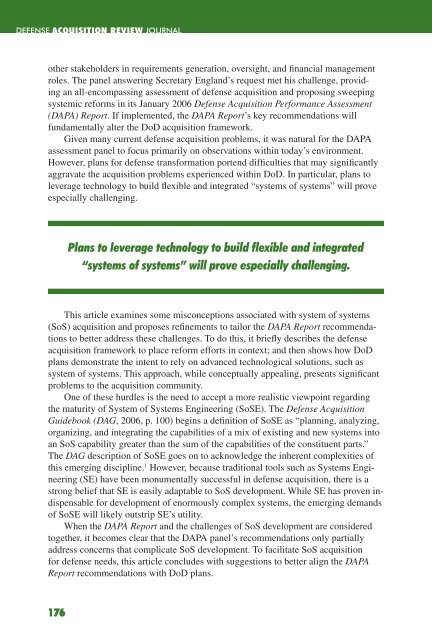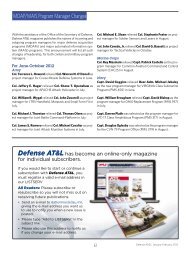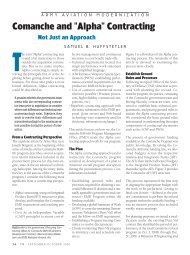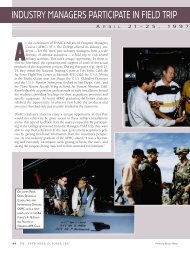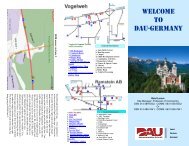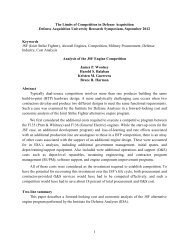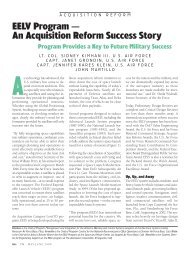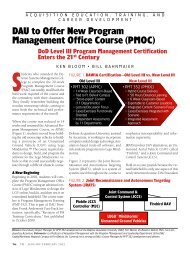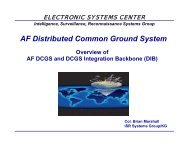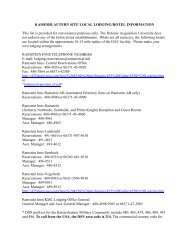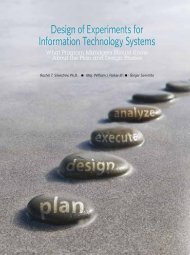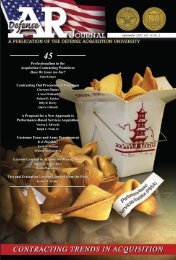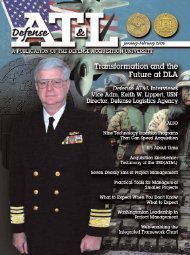Defense ARJ - Defense Acquisition University
Defense ARJ - Defense Acquisition University
Defense ARJ - Defense Acquisition University
You also want an ePaper? Increase the reach of your titles
YUMPU automatically turns print PDFs into web optimized ePapers that Google loves.
<strong>Defense</strong> <strong>Acquisition</strong> Review Journal<br />
other stakeholders in requirements generation, oversight, and financial management<br />
roles. The panel answering Secretary England’s request met his challenge, providing<br />
an all-encompassing assessment of defense acquisition and proposing sweeping<br />
systemic reforms in its January 2006 <strong>Defense</strong> <strong>Acquisition</strong> Performance Assessment<br />
(DAPA) Report. If implemented, the DAPA Report’s key recommendations will<br />
fundamentally alter the DoD acquisition framework.<br />
Given many current defense acquisition problems, it was natural for the DAPA<br />
assessment panel to focus primarily on observations within today’s environment.<br />
However, plans for defense transformation portend difficulties that may significantly<br />
aggravate the acquisition problems experienced within DoD. In particular, plans to<br />
leverage technology to build flexible and integrated “systems of systems” will prove<br />
especially challenging.<br />
This article examines some misconceptions associated with system of systems<br />
(SoS) acquisition and proposes refinements to tailor the DAPA Report recommendations<br />
to better address these challenges. To do this, it briefly describes the defense<br />
acquisition framework to place reform efforts in context; and then shows how DoD<br />
plans demonstrate the intent to rely on advanced technological solutions, such as<br />
system of systems. This approach, while conceptually appealing, presents significant<br />
problems to the acquisition community.<br />
One of these hurdles is the need to accept a more realistic viewpoint regarding<br />
the maturity of System of Systems Engineering (SoSE). The <strong>Defense</strong> <strong>Acquisition</strong><br />
Guidebook (DAG, 2006, p. 100) begins a definition of SoSE as “planning, analyzing,<br />
organizing, and integrating the capabilities of a mix of existing and new systems into<br />
an SoS capability greater than the sum of the capabilities of the constituent parts.”<br />
The DAG description of SoSE goes on to acknowledge the inherent complexities of<br />
this emerging discipline. 1 However, because traditional tools such as Systems Engineering<br />
(SE) have been monumentally successful in defense acquisition, there is a<br />
strong belief that SE is easily adaptable to SoS development. While SE has proven indispensable<br />
for development of enormously complex systems, the emerging demands<br />
of SoSE will likely outstrip SE’s utility.<br />
When the DAPA Report and the challenges of SoS development are considered<br />
together, it becomes clear that the DAPA panel’s recommendations only partially<br />
address concerns that complicate SoS development. To facilitate SoS acquisition<br />
for defense needs, this article concludes with suggestions to better align the DAPA<br />
Report recommendations with DoD plans.<br />
176<br />
Plans to leverage technology to build flexible and integrated<br />
“systems of systems” will prove especially challenging.


